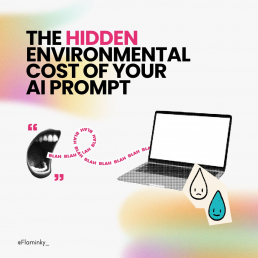
When we ask artificial intelligence to generate an image, video, or piece of writing — whether that’s a holiday itinerary, a blog post, or a deepfake of a celebrity eating a Greggs sausage roll — we rarely think about what it takes to make that response happen. It’s just a line of text and a click, right?
Wrong.
Behind every AI-generated answer is a massive environmental footprint, one that’s growing faster than we realise — and that footprint has a name: data centres.
The AI Industry’s Dirty Secret
Every time you interact with AI — whether it’s ChatGPT, Midjourney, DALL·E, or Google Veo — your request is processed by thousands of computers stored in vast server rooms. These servers don’t run on magic. They consume electricity, pump out heat, and require huge amounts of water to cool down. This is particularly true for large language models and video-generation AIs, which are computationally intensive.
And with the world’s obsession with AI skyrocketing, the environmental cost is scaling with it.
Water: The Invisible Cost of Intelligence
A single AI model, during its training phase, can consume millions of litres of water. When AI companies say they’re “training” a model, they’re essentially putting thousands of GPUs (graphics processing units) through months of high-intensity computation, which generates immense heat.
How is that heat managed?
Water cooling systems.
According to a 2023 report, training OpenAI’s GPT-3 in Microsoft’s data centres consumed approximately 700,000 litres of clean water. And that’s just one model. Every AI response you prompt after that adds to the ongoing usage. Meta, Google, and Amazon also use millions of litres of water per day to keep their AI servers stable and functioning.
Electricity and Carbon Emissions
It’s not just about water. AI consumes an astonishing amount of power, often sourced from fossil-fuel-heavy grids. In 2022, data centres accounted for roughly 1–1.5% of the world’s electricity consumption — and with AI exploding in popularity since then, that figure is only climbing.
To put things in perspective:
-
Generating one AI image can use as much power as charging your phone 30 times.
-
Training a single AI model can emit up to 284 tonnes of CO₂ — that’s the equivalent of 60 petrol cars driving for a year.
What Even Is a Server Room?
Imagine a gigantic warehouse filled with rows upon rows of machines stacked in towers — constantly running, constantly humming, constantly consuming power. These are server farms, and they’re the backbone of the internet and AI.
The irony? Some of these server centres are now being built in deserts, including Arizona — one of the driest places on Earth — where water for cooling is already in scarce supply.
AI Sustainability: Greenwashing or Progress?
Tech giants like Google and Microsoft claim they are working towards carbon neutrality and “green AI.” Some are investing in air cooling, renewable energy, and liquid immersion cooling (where servers are dunked in non-conductive liquid to keep them cool without evaporating water).
But critics argue these efforts are slow and performative — especially as companies race to release bigger, faster, and more powerful AI tools without pause. If each model release requires exponentially more energy, is “sustainability” even possible at that scale?
What Can We Do?
We’re not saying “don’t use AI” — it’s an incredible tool and part of the future. But we need awareness and responsibility. Here’s what that can look like:
-
Use AI mindfully — not just for novelty or spammy content.
-
Support AI tools from companies making transparent, measurable green efforts.
-
Advocate for tech policy and regulations that hold AI companies accountable for environmental impacts.
-
If you’re a creator, brand or business, ask how your content is being made — and what it costs the planet.
Final Thoughts: There’s No Such Thing as a “Free” Prompt
Just because AI feels weightless doesn’t mean it’s without weight. Every time we ask a bot to dream, something in the real world works harder, burns hotter, and drinks more water to make that dream come true.
At Flaminky, we believe in technology that not only fuels creativity but does so responsibly. In a world increasingly shaped by code, it’s time we thought beyond the keyboard — and considered what our prompts are really asking of the planet.
